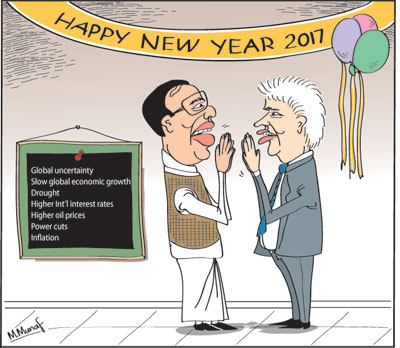Columns
2017 a challenging year; global uncertainty, higher oil prices, drought and energy crunch
View(s):The new year that has just dawned will be a challenging one. Global economic conditions are uncertain, world economic growth sluggish, oil prices expected to increase and drought and power cuts are expected. Tea prices, workers’ remittances and tourist earnings are expected to increase. While the trade deficit is likely to be high owing to import expenditure increasing more than increases in export earnings. Nevertheless earnings from services are expected to offset the large trade deficit to generate a current account surplus. An improvement in the country’s foreign reserves could be expected owing to this and lesser debt service obligations.
 Global conditions
Global conditions
The global economic environment is difficult to predict. Economic policies of the next US President who assumes office on January 20th are uncertain and confusing. Their repercussion on the global economy is even more difficult to predict.
Interest rates
US interest rates are likely to increase and thereby increase the country’s debt burden as well as reduce inflows of investable funds. Higher interest rates in the US mean lesser outflow of investment funds. The interest costs of further borrowing would also be higher. An increase in US interest rates and less liberal trade policies could affect countries like Sri Lanka adversely.
Europe
The emigrant crisis and bringing into power inflexible political leaders in Europe may disrupt European economies. European economic growth is not expected to be robust.
 World economic outlook
World economic outlook
The global economy is expected to grow rather slowly with most growth being from Asian economies that are not our main export markets. Consequently the demand for manufactured exports will be slow. Tea prices are likely to rise owing to the increase in oil prices increasing incomes in oil producing countries that are significant markets for tea. The higher oil prices would also increase rubber prices.
Escalating oil prices
International oil prices have begun to rise and are expected to increase from below US$ 50 per barrel to US$ 60 or above. This over 20 percent increase in oil price would increase our oil import bill by about US$ 1 billion. However some countervailing benefits on exports and remittances would offset some of these disadvantages. Most pointers at this stage are unfavourable to Sri Lanka’s debt ridden trade dependent economy.
Exports Benefits
The improvement in oil prices are expected to enhance the demand for the country’s tea exports to Russia and the Middle East. The increase in incomes of Middle Eastern countries could improve employment and wages of our migrant workers and enhance workers’ remittances. These remittances are a huge support to the balance of payments as they could offset a high proportion of the large trade deficit in 2017.
Tea
Indications are that there would be a recovery in tea export earnings that fell last year. The economic improvement in some of the country’s most important markets for tea – Russia and the Middle East – owing to better prices for oil, as well as the lower tea production in other countries is expect to increase international tea prices.
However an important determinant of the extent by which tea exports would increase depends on the performance of tea production this year. There has to be a reversal of last year’s fall in production owing to several factors apart from the price decline. These are rainfall this year, availability of fertiliser, labour productivity and constraints on weeding with the non-availability of crucial weedicides, while labour is in short supply.
Rubber and fish exports
An increase in rubber prices owing to the price rise in oil would increase export earnings to some extent. However the exportable rubber surplus is small. Fish exports to Europe are likely to increase owing to the lifting of the import ban in Europe. If the long awaited GSP plus concession is restored it may help boost exports of manufactures.
Inflation
The rate of inflation is likely to rise during the year owing to higher prices of rice, oil, energy and perhaps transport. The depreciation of the Rupee and perhaps its further depreciation would be an important factor in cost push inflation. Interest rates are likely to be increased to cope with inflationary pressures. Without competitive exchange rates export growth will be adversely affected. And, high interest rates which would help to contain aggregate demand will act as a damper on likely inflation.
Impact of drought
The drought conditions of last year and its expected continuation would affect food production. The fall in rice production would increase rice prices and harden the livelihoods of farmers. Food security of the poorer sections is threatened by low incomes and high food prices. Rice imports would increase the trade deficit through higher import expenditure.
In addition, the lesser generation of hydrogenation of electricity and greater dependence on thermal generation means larger imports of oil during a year when oil prices are expected to escalate.
Energy crunch
Economic growth is seriously threatened by the energy shortage not only this year but in the years ahead as well. Energy generation is not increasing at the rate of energy demand. New power projects that will meet the energy demand must be put in place to ensure that economic activities would not be hampered.
Since the generation of adequate energy would take time, GDP growth in construction, manufacturing and services would suffer meanwhile. It would have extremely adverse consequences with long power cuts, fall in production and employment. Abandoning coal without replacing it with a viable and cost effective alternative would be disastrous for this country which has now come to depend on electricity.
High rise buildings would have little value when elevators do not function due to power cuts. In house generation of power would be vastly more expensive.
All things considered
All things considered, the economy is not likely to grow any faster this year than in the last. It may be less. A modest economic performance of less than 5 percent is likely. If the threats and challenges are severe the economy may fare rather less.
The government’s ability to implement an agreed economic policy, effectiveness in implementing economic reforms, and containment of social tensions would determine much of the economy’s performance in 2017.
Economic growth in 2017 and beyond would be determined in as much by the uncertain global economic conditions as the government reaching an economic policy consensus and having a strong resolve and determination to implement an agreed policy program.


Leave a Reply
Post Comment